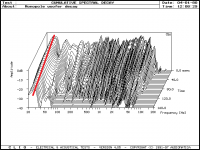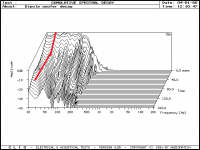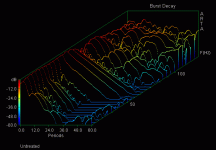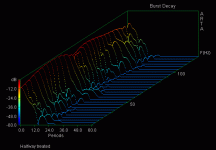When it comes to decay and resonances I would say the monopoles performs overall better. They are noticeable better between 70-200 Hz. The frequency response is clearly improved with the dipoles. Would be interesting to see what change of placements of both subs and sitting postion would do.
How would you say that monopole is better at 70-200 HZ. From listening experience, it is this very midbass region ( 40-120 Hz) where dipoles truly excel without any equalization and provide an excellent transient response where the sharp thump of a kickdrum is palpable. Below 40Hz, I agree that dipoles are inefficient.
Last edited:
I was commenting StigErik's measurements. They show less resonances and shorter decay in that area with the monopole.How would you say that monopole is better at 70-200 HZ. From listening experience, it is this very midbass region ( 40-120 Hz) where dipoles truly excel without any equalization and provide an excellent transient response where the sharp thump of a kickdrum is palpable. Below 40Hz, I agree that dipoles are inefficient.
The decay is not shorter. The length of the room decay is the same. Its the LEVEL of the roomdecay that is different.
I was commenting StigErik's measurements. They show less resonances and shorter decay in that area with the monopole.
No they don't. You have misinterpreted the graphs. It's actually the other way around, although the decay time is the same.
I understood what you said below, but I was simply commenting my comment.No they don't. You have misinterpreted the graphs. It's actually the other way around, although the decay time is the same.
And doesn't it also prove we are back to square one? It's what Gedlee has described many times. We are not comparing correctly and fairly.
The difference is not what it seems, because the overall response from the monopole is uneven, and this affects the level of the decay as well. It may look like the decay is lower, but this is only because the speaker level is also lower. It would have been easier to compare the two if the monopole was EQ'ed to a flat response.
One other thing is that the dipole room decay starts at a level 15-20 dB below the speaker, while the monopole starts at the same level as the speaker.
I don't think the discussion monopole vs dipole doesn't make much sense right now. Even more so if there's no comparable data.
Truck or car, which one is better? The question is: what is the goal and what are the tradeoffs using one solution over the other?
Truck or car, which one is better? The question is: what is the goal and what are the tradeoffs using one solution over the other?
To make a bullet-proof scientific and well documented comparison between dipole and monopole is a lot of work, and I am not going to do it.
I was just presenting my own view and experience on this, which just happens to be shared by virtually everyone who has any experience with dipoles. But we could be wrong of course.....
The most important thing for me is that my dipole bass is the best bass I've ever had.
I was just presenting my own view and experience on this, which just happens to be shared by virtually everyone who has any experience with dipoles. But we could be wrong of course.....
The most important thing for me is that my dipole bass is the best bass I've ever had.
Take a look at my decay measurements again. The monopole has got one long decay, while the dipole has got at "knee" where the room decay really starts.
I know my data is far from comparable, but it shows an interesting difference between dipole and monopole.
I know my data is far from comparable, but it shows an interesting difference between dipole and monopole.
Attachments
Take a look at my decay measurements again. The monopole has got one long decay, while the dipole has got at "knee" where the room decay really starts.
Was the monopole placed at the same distance to the receiver as the dipole?
The decay is not shorter. The length of the room decay is the same. Its the LEVEL of the roomdecay that is different.
This observation from the graphs by StigErik is the key evidence for the better transient response in a room from a dipole.
The room decay is a function of room acoustics and will be the same independent of the source. However if less sound waves reach the room boundaries, the SPL of the reverberant field is lower to start with for a bidirectional dipole as opposed to a monopole that is omnidirectional. So logically, the ratio of the direct to indirect soundfield higher for a dipole than a monopole. Higher direct sound equals to reduced room coloration...this is true for any speaker. That is why some listeners who prefer uncoloured sound in their rooms go for narrow directivity speakers like horn loaded ones. The only other way to reduce room colourations is to increase wall absorption. While room treatments work well and inexpensively for mid-high frequencies, it is not so for bass frequencies. So the only way to reduce the room colourations in the bass region is to get narrow directivity in the bass region....using a dipole bass unit !
Following the above line of thought, a monopole and a dipole should sound the same in open air or anechoic conditions. Unfortunately even that might not be true...as the backwave from a sealed monopole can never be completely absorbed (unless it is a rare long stuffed sealed TL) the unaccounted and un-simulatable stored energy from a monopole eventually comes out, smearing the sound envelope. In contrast, in a dipole all the energy is accounted for to a greater extent.
This observation from the graphs by StigErik is the key evidence for ...
And this graph is the "key evidence" for what?
An externally hosted image should be here but it was not working when we last tested it.
Double Bass Array (DBA) - The modern bass concept!
You can't compare that to StigEriks' room anyway. Rooms are different. It would have to be in the same room, if it's going to have any meaning at all.And now I'd like to see such data for multiple locations in different rooms 🙂
What we're seeing for sure are modal issues with both. Just as expected.
If one thinks he will get from here:
To here:
by going from monopole to dipole or with multiple subs, they are wrong. There's no free lunch here.
Attachments
Last edited:
You can't compare that to StigEriks' room anyway. Rooms are different. It would have to be in the same room, if it's going to have any meaning at all.
I didn't claim the opposite 😕
What's the difference between the two rooms you've shown? Those plots don't look right.
Last edited:
Same room and same speakers. Treatment is the difference.What's the difference between the two rooms you've shown? Those plots don't look right.
Same room and same speakers. Treatment is the difference.
That's obvious but what IS the difference (room size, source/receiver locations, treatments, etc.).
You're showing a 60dB range without any noise floor visible. That's uncommon.
Thanks Wavebourn.
BTW, why do you prefer arrays over single very high efficiency drivers, when comparable SPL can be reached by both in the home environment with no possibility comb filtering with the single driver. Unless you say that you used multiple high efficiency drivers in the array !!
I am tired from this "Comb filtering" myth...
- Status
- Not open for further replies.
- Home
- General Interest
- Room Acoustics & Mods
- Measured monopole and dipole room responses



